steering VOLVO XC60 TWIN ENGINE 2019 Owners Manual
[x] Cancel search | Manufacturer: VOLVO, Model Year: 2019, Model line: XC60 TWIN ENGINE, Model: VOLVO XC60 TWIN ENGINE 2019Pages: 695, PDF Size: 14.96 MB
Page 7 of 695
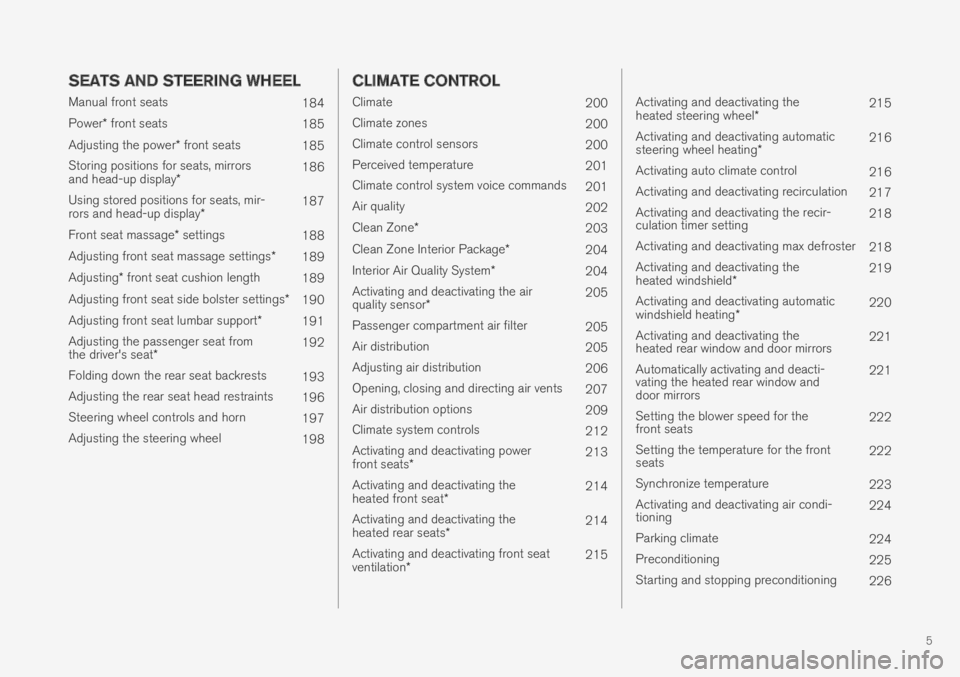
5
SEATS AND STEERING WHEEL
Manual front seats184
Power* front seats185
Adjusting the power* front seats185
Storing positions for seats, mirrorsand head-up display*186
Using stored positions for seats, mir-rors and head-up display*187
Front seat massage* settings188
Adjusting front seat massage settings*189
Adjusting* front seat cushion length189
Adjusting front seat side bolster settings*190
Adjusting front seat lumbar support*191
Adjusting the passenger seat fromthe driver's seat*192
Folding down the rear seat backrests193
Adjusting the rear seat head restraints196
Steering wheel controls and horn197
Adjusting the steering wheel198
CLIMATE CONTROL
Climate200
Climate zones200
Climate control sensors200
Perceived temperature201
Climate control system voice commands201
Air quality202
Clean Zone*203
Clean Zone Interior Package*204
Interior Air Quality System*204
Activating and deactivating the airquality sensor*205
Passenger compartment air filter205
Air distribution205
Adjusting air distribution206
Opening, closing and directing air vents207
Air distribution options209
Climate system controls212
Activating and deactivating powerfront seats*213
Activating and deactivating theheated front seat*214
Activating and deactivating theheated rear seats*214
Activating and deactivating front seatventilation*215
Activating and deactivating theheated steering wheel*215
Activating and deactivating automaticsteering wheel heating*216
Activating auto climate control216
Activating and deactivating recirculation217
Activating and deactivating the recir-culation timer setting218
Activating and deactivating max defroster218
Activating and deactivating theheated windshield*219
Activating and deactivating automaticwindshield heating*220
Activating and deactivating theheated rear window and door mirrors221
Automatically activating and deacti-vating the heated rear window anddoor mirrors
221
Setting the blower speed for thefront seats222
Setting the temperature for the frontseats222
Synchronize temperature223
Activating and deactivating air condi-tioning224
Parking climate224
Preconditioning225
Starting and stopping preconditioning226
Page 9 of 695
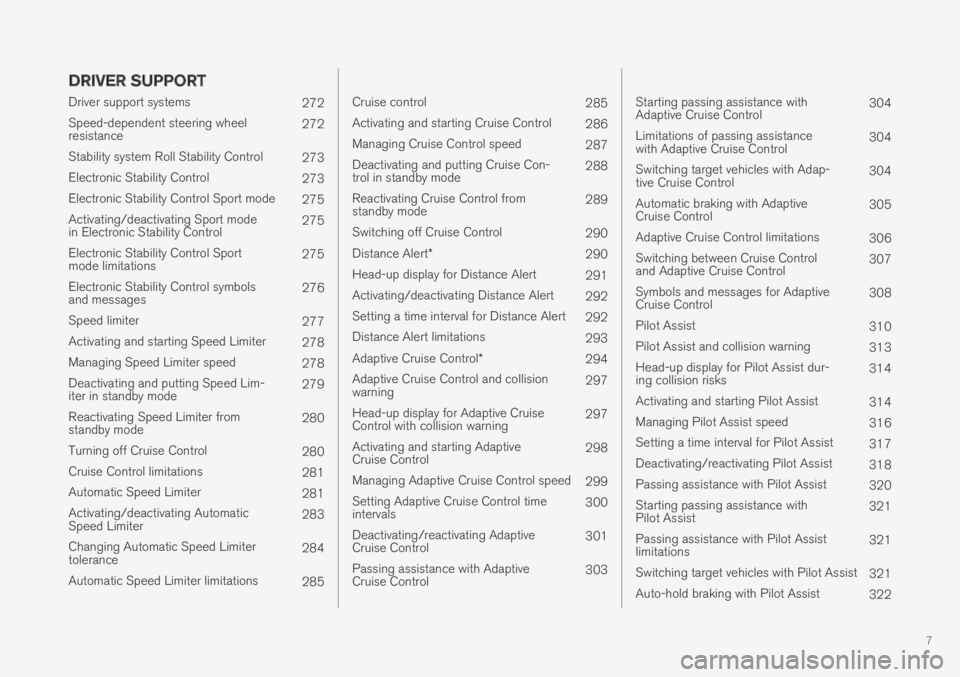
7
DRIVER SUPPORT
Driver support systems272
Speed-dependent steering wheelresistance272
Stability system Roll Stability Control273
Electronic Stability Control273
Electronic Stability Control Sport mode275
Activating/deactivating Sport modein Electronic Stability Control275
Electronic Stability Control Sportmode limitations275
Electronic Stability Control symbolsand messages276
Speed limiter277
Activating and starting Speed Limiter278
Managing Speed Limiter speed278
Deactivating and putting Speed Lim-iter in standby mode279
Reactivating Speed Limiter fromstandby mode280
Turning off Cruise Control280
Cruise Control limitations281
Automatic Speed Limiter281
Activating/deactivating AutomaticSpeed Limiter283
Changing Automatic Speed Limitertolerance284
Automatic Speed Limiter limitations285
Cruise control285
Activating and starting Cruise Control286
Managing Cruise Control speed287
Deactivating and putting Cruise Con-trol in standby mode288
Reactivating Cruise Control fromstandby mode289
Switching off Cruise Control290
Distance Alert*290
Head-up display for Distance Alert291
Activating/deactivating Distance Alert292
Setting a time interval for Distance Alert292
Distance Alert limitations293
Adaptive Cruise Control*294
Adaptive Cruise Control and collisionwarning297
Head-up display for Adaptive CruiseControl with collision warning297
Activating and starting AdaptiveCruise Control298
Managing Adaptive Cruise Control speed299
Setting Adaptive Cruise Control timeintervals300
Deactivating/reactivating AdaptiveCruise Control301
Passing assistance with AdaptiveCruise Control303
Starting passing assistance withAdaptive Cruise Control304
Limitations of passing assistancewith Adaptive Cruise Control304
Switching target vehicles with Adap-tive Cruise Control304
Automatic braking with AdaptiveCruise Control305
Adaptive Cruise Control limitations306
Switching between Cruise Controland Adaptive Cruise Control307
Symbols and messages for AdaptiveCruise Control308
Pilot Assist310
Pilot Assist and collision warning313
Head-up display for Pilot Assist dur-ing collision risks314
Activating and starting Pilot Assist314
Managing Pilot Assist speed316
Setting a time interval for Pilot Assist317
Deactivating/reactivating Pilot Assist318
Passing assistance with Pilot Assist320
Starting passing assistance withPilot Assist321
Passing assistance with Pilot Assistlimitations321
Switching target vehicles with Pilot Assist321
Auto-hold braking with Pilot Assist322
Page 10 of 695

8
Pilot Assist limitations323
Pilot Assist* symbols and messages324
Radar sensor326
Radar sensor limitations327
Recommended maintenance for theradar sensor330
Radar sensor type approval330
Camera331
Camera limitations332
Recommended maintenance for thecamera/radar sensor335
City Safety™335
City Safety parameters and sub-functions336
Setting a warning distance for City Safety338
Detecting obstacles with City Safety339
City Safety in crossing traffic341
Limitations of City Safety in crossingtraffic342
City Safety steering assistance forevasive maneuver343
City Safety steering assistance limi-tations during evasive maneuvers343
City Safety and delayed evasivemaneuvers344
City Safety braking for oncomingvehicles*345
City Safety limitations346
City Safety messages348
Rear Collision Warning349
Rear Collision Warning limitations349
BLIS*350
Activating/deactivating BLIS351
BLIS limitations352
Recommended maintenance for BLIS353
BLIS messages354
Cross Traffic Alert*355
Activating/deactivating Cross TrafficAlert356
Cross Traffic Alert limitations356
Recommended maintenance forCross Traffic Alert357
Cross Traffic Alert messages358
Road Sign Information*359
Activating/deactivating Road SignInformation360
Road Sign Information and sign displays361
Road Sign Information and SensusNavigation361
Road Sign Information with SpeedWarning and Settings362
Activating/deactivating Speed Warn-ing in Road Sign Information363
Road Sign Information with speedcamera information363
Road Sign Information limitations364
Driver Alert Control365
Activating/deactivating Driver AlertControl366
Selecting guidance to a rest area ifthe Driver Alert Control warning hasbeen given
367
Driver Alert Control limitations367
Lane Keeping Aid367
Steering assistance with Lane Keep-ing Aid369
Activating/deactivating Lane Keeping Aid370
Selecting type of assistance for LaneKeeping Aid370
Lane Keeping Aid limitations371
Lane Keeping Aid symbols and mes-sages372
Lane Keeping Aid symbols in theinstrument panel374
Steering assistance at risk of collision375
Activating/deactivating steeringassistance during collision risks375
Run-Off Mitigation with steeringassistance376
Run-Off Mitigation with steeringassistance levels376
Activating/deactivating Run-Off Miti-gation with steering assistance377
Page 11 of 695
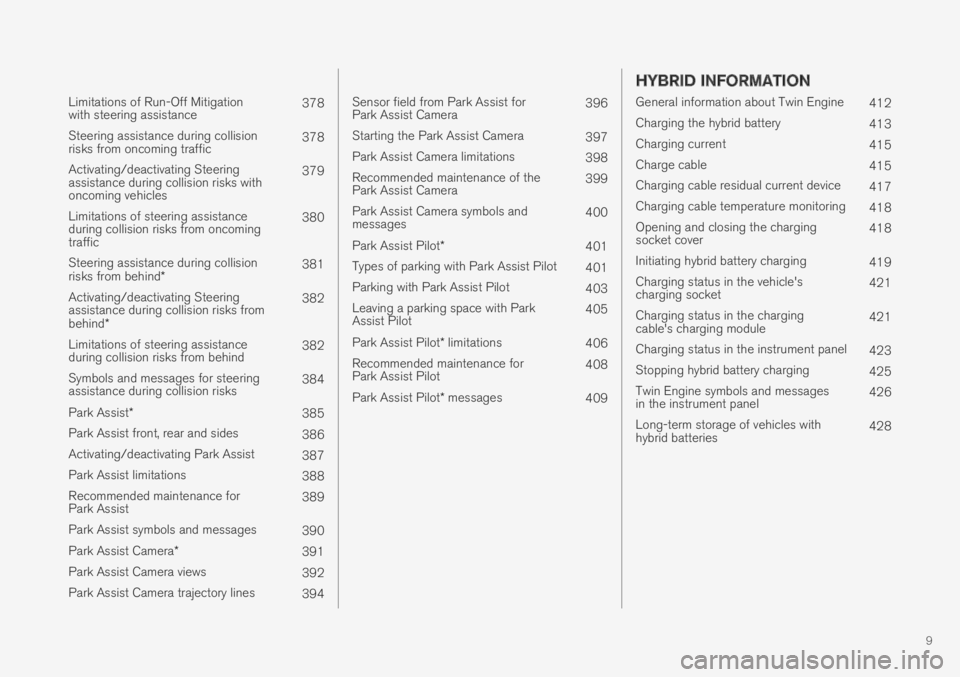
9
Limitations of Run-Off Mitigationwith steering assistance378
Steering assistance during collisionrisks from oncoming traffic378
Activating/deactivating Steeringassistance during collision risks withoncoming vehicles
379
Limitations of steering assistanceduring collision risks from oncomingtraffic
380
Steering assistance during collisionrisks from behind*381
Activating/deactivating Steeringassistance during collision risks frombehind*
382
Limitations of steering assistanceduring collision risks from behind382
Symbols and messages for steeringassistance during collision risks384
Park Assist*385
Park Assist front, rear and sides386
Activating/deactivating Park Assist387
Park Assist limitations388
Recommended maintenance forPark Assist389
Park Assist symbols and messages390
Park Assist Camera*391
Park Assist Camera views392
Park Assist Camera trajectory lines394
Sensor field from Park Assist forPark Assist Camera396
Starting the Park Assist Camera397
Park Assist Camera limitations398
Recommended maintenance of thePark Assist Camera399
Park Assist Camera symbols andmessages400
Park Assist Pilot* 401
Types of parking with Park Assist Pilot401
Parking with Park Assist Pilot403
Leaving a parking space with ParkAssist Pilot405
Park Assist Pilot* limitations 406
Recommended maintenance forPark Assist Pilot408
Park Assist Pilot* messages409
HYBRID INFORMATION
General information about Twin Engine412
Charging the hybrid battery413
Charging current415
Charge cable415
Charging cable residual current device417
Charging cable temperature monitoring418
Opening and closing the chargingsocket cover418
Initiating hybrid battery charging419
Charging status in the vehicle'scharging socket421
Charging status in the chargingcable's charging module421
Charging status in the instrument panel423
Stopping hybrid battery charging425
Twin Engine symbols and messagesin the instrument panel426
Long-term storage of vehicles withhybrid batteries428
Page 12 of 695
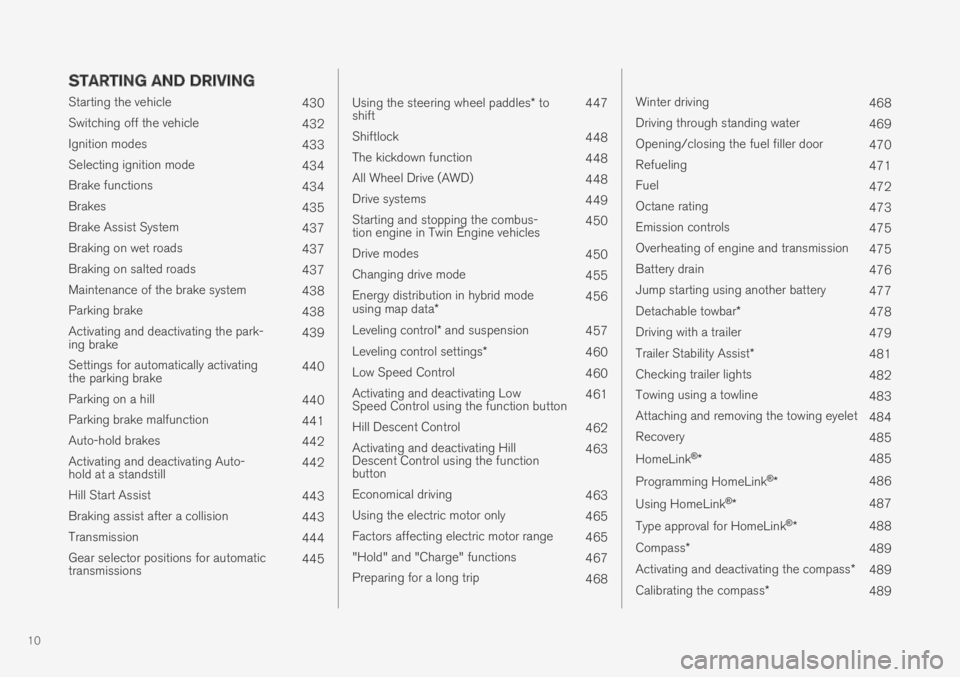
10
STARTING AND DRIVING
Starting the vehicle430
Switching off the vehicle432
Ignition modes433
Selecting ignition mode434
Brake functions434
Brakes435
Brake Assist System437
Braking on wet roads437
Braking on salted roads437
Maintenance of the brake system438
Parking brake438
Activating and deactivating the park-ing brake439
Settings for automatically activatingthe parking brake440
Parking on a hill440
Parking brake malfunction441
Auto-hold brakes442
Activating and deactivating Auto-hold at a standstill442
Hill Start Assist443
Braking assist after a collision443
Transmission444
Gear selector positions for automatictransmissions445
Using the steering wheel paddles* toshift447
Shiftlock448
The kickdown function448
All Wheel Drive (AWD)448
Drive systems449
Starting and stopping the combus-tion engine in Twin Engine vehicles450
Drive modes450
Changing drive mode455
Energy distribution in hybrid modeusing map data*456
Leveling control* and suspension457
Leveling control settings*460
Low Speed Control460
Activating and deactivating LowSpeed Control using the function button461
Hill Descent Control462
Activating and deactivating HillDescent Control using the functionbutton
463
Economical driving463
Using the electric motor only465
Factors affecting electric motor range465
"Hold" and "Charge" functions467
Preparing for a long trip468
Winter driving468
Driving through standing water469
Opening/closing the fuel filler door470
Refueling471
Fuel472
Octane rating473
Emission controls475
Overheating of engine and transmission475
Battery drain476
Jump starting using another battery477
Detachable towbar*478
Driving with a trailer479
Trailer Stability Assist*481
Checking trailer lights482
Towing using a towline483
Attaching and removing the towing eyelet484
Recovery485
HomeLink®*485
Programming HomeLink®*486
Using HomeLink®*487
Type approval for HomeLink®*488
Compass*489
Activating and deactivating the compass*489
Calibrating the compass*489
Page 15 of 695
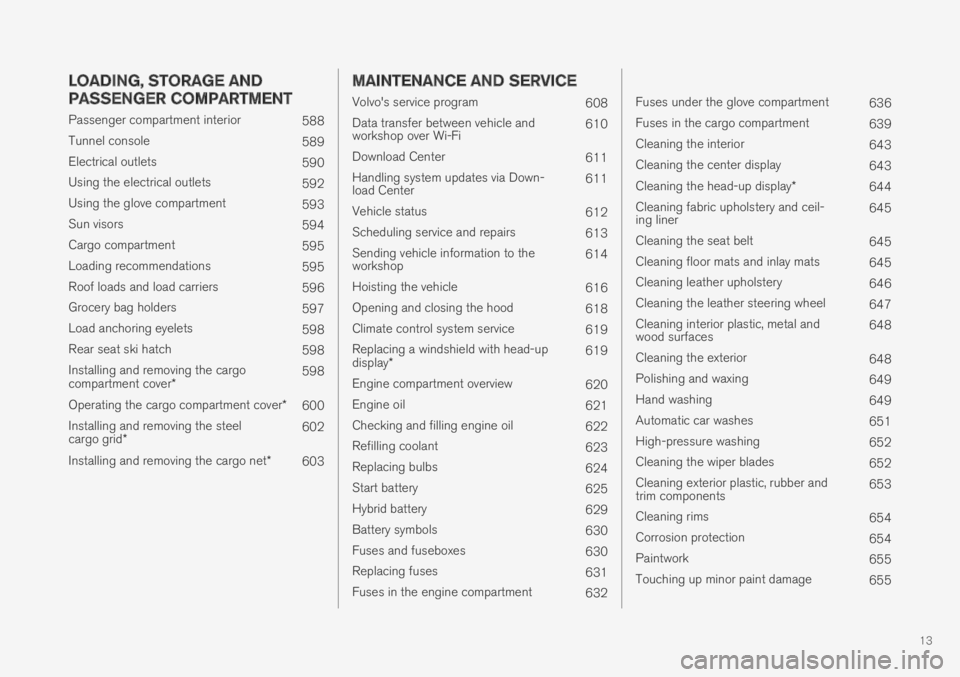
13
LOADING, STORAGE AND
PASSENGER COMPARTMENT
Passenger compartment interior588
Tunnel console589
Electrical outlets590
Using the electrical outlets592
Using the glove compartment593
Sun visors594
Cargo compartment595
Loading recommendations595
Roof loads and load carriers596
Grocery bag holders597
Load anchoring eyelets598
Rear seat ski hatch598
Installing and removing the cargocompartment cover*598
Operating the cargo compartment cover*600
Installing and removing the steelcargo grid*602
Installing and removing the cargo net*603
MAINTENANCE AND SERVICE
Volvo's service program608
Data transfer between vehicle andworkshop over Wi-Fi610
Download Center611
Handling system updates via Down-load Center611
Vehicle status612
Scheduling service and repairs613
Sending vehicle information to theworkshop614
Hoisting the vehicle616
Opening and closing the hood618
Climate control system service619
Replacing a windshield with head-updisplay*619
Engine compartment overview620
Engine oil621
Checking and filling engine oil622
Refilling coolant623
Replacing bulbs624
Start battery625
Hybrid battery629
Battery symbols630
Fuses and fuseboxes630
Replacing fuses631
Fuses in the engine compartment632
Fuses under the glove compartment636
Fuses in the cargo compartment639
Cleaning the interior643
Cleaning the center display643
Cleaning the head-up display*644
Cleaning fabric upholstery and ceil-ing liner645
Cleaning the seat belt645
Cleaning floor mats and inlay mats645
Cleaning leather upholstery646
Cleaning the leather steering wheel647
Cleaning interior plastic, metal andwood surfaces648
Cleaning the exterior648
Polishing and waxing649
Hand washing649
Automatic car washes651
High-pressure washing652
Cleaning the wiper blades652
Cleaning exterior plastic, rubber andtrim components653
Cleaning rims654
Corrosion protection654
Paintwork655
Touching up minor paint damage655
Page 30 of 695

||
YOUR VOLVO
* Option/accessory.28
goal. In addition to continuous environmentalrefinement of conventional gasoline-poweredinternal combustion engines, Volvo is activelylooking at advanced technology alternative-fuelvehicles.
When you drive a Volvo, you become our partnerin the work to lessen the vehicle's impact on theenvironment. To reduce your vehicle's environ-mental impact, you can:
Maintain proper air pressure in your tires.Tests have shown decreased fuel economywith improperly inflated tires.
Follow the recommended maintenanceschedule in your Warranty and ServiceRecords Information booklet.
Drive at a constant speed whenever possible.
See a trained and qualified Volvo servicetechnician as soon as possible for inspectionif the check engine (malfunction indicator)light illuminates, or stays on after the vehiclehas started.
Properly dispose of any vehicle-related wastesuch as used motor oil, used batteries, brakepads, etc.
When cleaning your vehicle, please use gen-uine Volvo car care products. All Volvo carcare products are formulated to be environ-mentally friendly.
Twin Engine vehicles
If possible, precondition the vehicle with thecharging cable before driving.
If preconditioning is not possible in coldweather, use the seat and steering wheelheating primarily. Avoid heating the entirepassenger compartment, which reduces thehybrid battery's charge level.
Choose the Pure drive mode to help mini-mize electric power consumption.
In hilly terrain, put the gear selector in modeB to utilize the electric motor's braking func-tion when the accelerator pedal is released.This helps charge the hybrid battery.
Related information
Economical driving (p. 463)
Starting and stopping preconditioning(p. 226)
The Owner's Manual and the environment(p. 24)
Air quality (p. 202)
IntelliSafe - driver support
IntelliSafe is Volvo Cars' philosophy regardingvehicle safety. IntelliSafe consists of a number ofsystems, both standard and optional, that aredesigned to help make driving safer, preventaccidents and protect passengers and otherroad users.
Support
IntelliSafe includes driver support functions suchas Adaptive cruise control* which helps the driverto maintain an even speed combined with a pre-selected time interval to the vehicle ahead.
Pilot Assist2 helps the driver keep the vehicle inthe current traffic lane by providing steeringassistance and maintaining an even speed and aset time interval to the vehicle ahead.
Park Assist Pilot* helps the driver pull into andout of parking spaces.
Other examples of systems that can help thedriver are the Active main beam, Cross TrafficAlert (CTA)* and Blind Spot Information (BLIS)*systems.
Prevention
City Safety is a function intended to help preventaccidents. The function can help prevent or miti-gate a collision with pedestrians, cyclists, largeanimals or other vehicles. Light, sound and pulsa-tions in the brake pedal are provided to alert of a
2Depending on market, this function can be either standard or optional.
Page 31 of 695
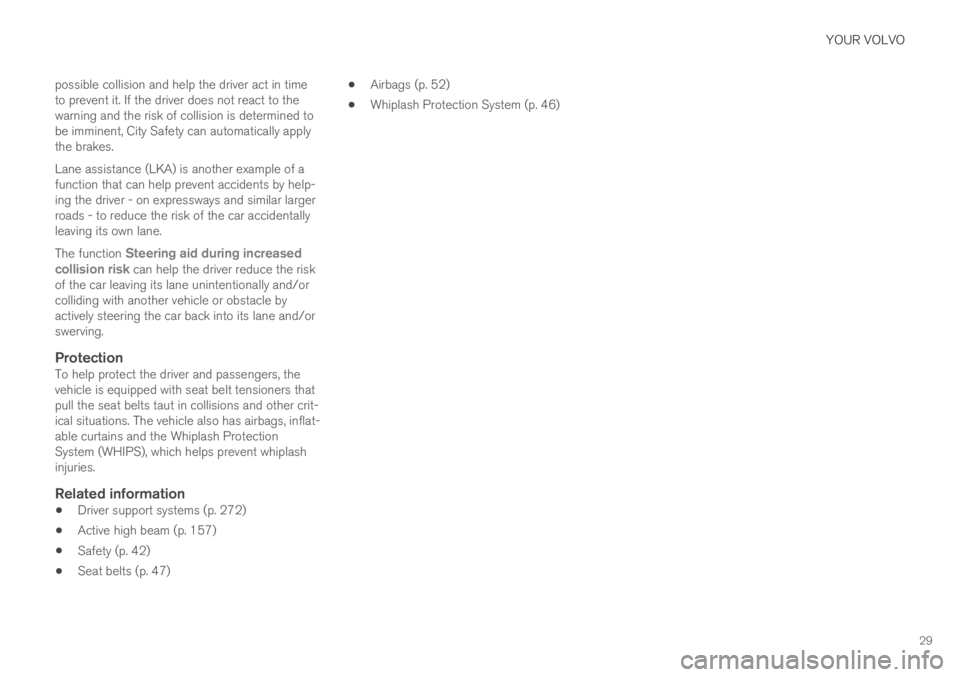
YOUR VOLVO
29
possible collision and help the driver act in timeto prevent it. If the driver does not react to thewarning and the risk of collision is determined tobe imminent, City Safety can automatically applythe brakes.
Lane assistance (LKA) is another example of afunction that can help prevent accidents by help-ing the driver - on expressways and similar largerroads - to reduce the risk of the car accidentallyleaving its own lane.
The function Steering aid during increasedcollision risk can help the driver reduce the riskof the car leaving its lane unintentionally and/orcolliding with another vehicle or obstacle byactively steering the car back into its lane and/orswerving.
Protection
To help protect the driver and passengers, thevehicle is equipped with seat belt tensioners thatpull the seat belts taut in collisions and other crit-ical situations. The vehicle also has airbags, inflat-able curtains and the Whiplash ProtectionSystem (WHIPS), which helps prevent whiplashinjuries.
Related information
Driver support systems (p. 272)
Active high beam (p. 157)
Safety (p. 42)
Seat belts (p. 47)
Airbags (p. 52)
Whiplash Protection System (p. 46)
Page 33 of 695

YOUR VOLVO
}}
* Option/accessory.31
Different types of information are shown in different displays depending on how the information should be prioritized.
Head-up display *
The head-up display presents information thatthe driver should react to immediately.For example, traffic warnings, speed information
and navigation messages*. Road sign informationand incoming phone calls are also shown in thehead-up display. These can be handled using theright-side steering wheel keypad or the centerdisplay.
Instrument panel
The instrument panel displays informationsuch as speed, incoming phone calls or the track
Page 38 of 695
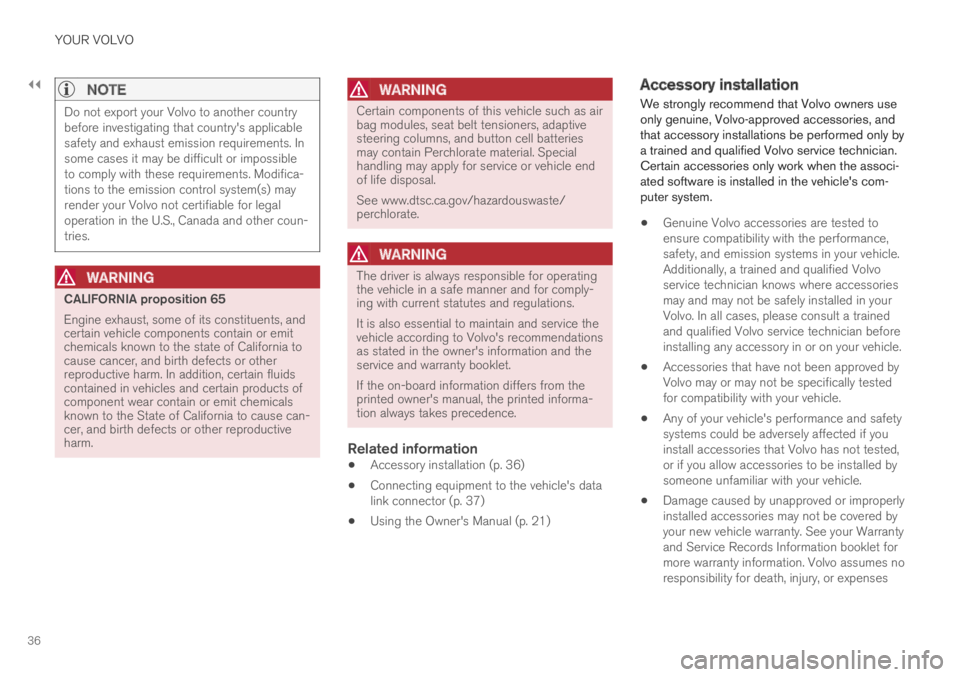
||
YOUR VOLVO
36
NOTE
Do not export your Volvo to another countrybefore investigating that country's applicablesafety and exhaust emission requirements. Insome cases it may be difficult or impossibleto comply with these requirements. Modifica-tions to the emission control system(s) mayrender your Volvo not certifiable for legaloperation in the U.S., Canada and other coun-tries.
WARNING
CALIFORNIA proposition 65
Engine exhaust, some of its constituents, andcertain vehicle components contain or emitchemicals known to the state of California tocause cancer, and birth defects or otherreproductive harm. In addition, certain fluidscontained in vehicles and certain products ofcomponent wear contain or emit chemicalsknown to the State of California to cause can-cer, and birth defects or other reproductiveharm.
WARNING
Certain components of this vehicle such as airbag modules, seat belt tensioners, adaptivesteering columns, and button cell batteriesmay contain Perchlorate material. Specialhandling may apply for service or vehicle endof life disposal.
See www.dtsc.ca.gov/hazardouswaste/perchlorate.
WARNING
The driver is always responsible for operatingthe vehicle in a safe manner and for comply-ing with current statutes and regulations.
It is also essential to maintain and service thevehicle according to Volvo's recommendationsas stated in the owner's information and theservice and warranty booklet.
If the on-board information differs from theprinted owner's manual, the printed informa-tion always takes precedence.
Related information
Accessory installation (p. 36)
Connecting equipment to the vehicle's datalink connector (p. 37)
Using the Owner's Manual (p. 21)
Accessory installation
We strongly recommend that Volvo owners useonly genuine, Volvo-approved accessories, andthat accessory installations be performed only bya trained and qualified Volvo service technician.Certain accessories only work when the associ-ated software is installed in the vehicle's com-puter system.
Genuine Volvo accessories are tested toensure compatibility with the performance,safety, and emission systems in your vehicle.Additionally, a trained and qualified Volvoservice technician knows where accessoriesmay and may not be safely installed in yourVolvo. In all cases, please consult a trainedand qualified Volvo service technician beforeinstalling any accessory in or on your vehicle.
Accessories that have not been approved byVolvo may or may not be specifically testedfor compatibility with your vehicle.
Any of your vehicle's performance and safetysystems could be adversely affected if youinstall accessories that Volvo has not tested,or if you allow accessories to be installed bysomeone unfamiliar with your vehicle.
Damage caused by unapproved or improperlyinstalled accessories may not be covered byyour new vehicle warranty. See your Warrantyand Service Records Information booklet formore warranty information. Volvo assumes noresponsibility for death, injury, or expenses